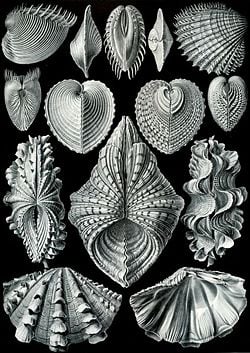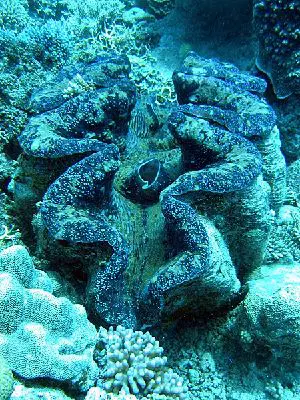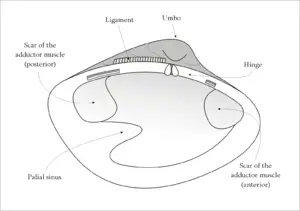Bivalve
| Bivalve | ||||||
|---|---|---|---|---|---|---|
 "Acephala" from Ernst Haeckel's Kunstformen der Natur, 1904
| ||||||
| Scientific classification | ||||||
| ||||||
|
Bivalves are aquatic mollusks belonging to the class Bivalvia (or Pelecypoda), a group that includes the familiar and economically important clams, oysters, scallops, and mussels. Bivalvia ("two valves") refers to the fact that most members of this group have two-part calcareous shells, or valves, that are hinged and more or less symmetrical. Pelecypoda ("hatchet-foot") refers to the common (but not always present) laterally compressed muscular foot, which when extended into sediment (sand or mud), can swell with blood and form a hatchet-shaped anchor (Towle 1989). Other names for the class include Bivalva and Lamellibranchia
The typically laterally compressed body and two valves makes bivalves superficially similar to brachiopods (lamp shells), which make up one of the major invertebrate phyla, Brachiopoda. However, they are not closely related and differ markedly in many ways. (See differences between brachiopods and bivalves.) For instance, bivalves usually have a plane of symmetry between the shells, whereas most brachiopods have a plane of bilateral symmetry through the shells and perpendicular to the hinge. Also bivalves use adductor muscles to hold the two shells closed and open them by means of an external or internal ligament once the adductor muscles are relaxed, whereas brachiopods use muscle power (to pull the shells apart and to close them.
Bivalvia has about 30,000 species, making them the second most diverse class of mollusks after Gastropoda ("univalves"). There are both marine and freshwater forms. Most bivalves are relatively sedentary suspension feeders, but they have various level of activites (some can even "swim" by jet propulsion) and not all are suspension feeders.
Many bivalves (clams, mussels, oysters, scallops, cockles) are important invertebrates for human consumptions, as well as key in food chains, being consumed by fish, marine mammals and other vertebrates, and various invertebrates. Both oysters and mussels are important for the production of pearls.
On the other hand, as filter feeders, bivalves may also concentrate bacteria, viruses, pesticides, industrial wastes, toxic metals, and petroleum derivates, and through consumption become vectors of human disease (Grzimet 2003). Shipworms (Teredinidae) cause bioerosion of human-made wooded structures, such as ships and docks, and other bivalves clog water treatment plants (Grzimet 2003).
Freshwater pearl mussels are among the most gravely threatened fauna in the world, comprising 185 of the 195 species of bivalves placed on the 2002 IUCN Red List (Grzimet 2003). In eastern NOrth America, 35% of the native species of freshwater pearl mussels are presumed extinct, and 69% are listed as endangered or threatened (Grzimet 2003). Among the antropogenic causes are habitat destruction through damming, dredging, and other such activities, overfishing, and pollution, including actions reducing populations of the fish hosts. Marine bivalves have fared much better, with no known recent extinctions, and none currently listed as threatened or endangerd (Grzimet 2003).
Characteristics
Found worldwide, bivalves are exclusively aquatic, requiring water for reproduction and respiration, and typically for feeding (Grzimet 2003). Shell morphology typically reflects the nature of the habitat, with calm-water species often having more delicate and leaflike shells compared to those subject to fast-flowing currents (Grzimet 2003).
Bivalves tend to be filter-feeders that extract organic matter from the water using their gills. The shipworm is one of the few bivalves that does not filter feed, but instead bores into drift wood (or docks, for that mater) and ingests particles produced by the drilling (Towle 1989). It is aided in digesting the wood by symbiotic bacteria that can digest cellulose. Septibranchia live in moderately deep water and create water currents by pumping, rather than ciliary action, and feed on copepod crustaceans (Russell-Hunter 1968). Some bivalves have symbiotic relationships with photosynthetic organisms, providing extra nutrition.
Most bivalves are relatively sedentary organisms, but they have various level of activites (some can even "swim" by jet propulsion) and not all are suspension feeders.
although they have various levels of activity, including usng the foot to move; some that can swim by waving the foot or tentacles; and some that can jet-propel themselves by rapidly clapping the shell valves together (reference 2003).
oysters become permanentl attache to hard surface early in development\\\\\\\ scallops move by opeing valves and rapidly snapping shut
As with all, Mollusks, bivalves are characterized by having a true coelom; organ systems for circulation, respiration, digestion, excretion, nerve conduction, and reproduction; and most mollusks have one or more shells and are bilaterially symmetrical (Towle 1989).
complete digestive tract, reduced nervours ystem, open circulatory sstyem with heart, arteries, venins; and excretory and reproducitve organs.
lack cephalic eyes and other sense organs, but many have tentacles and/or photorecopetors. More sophisticated eyes, equipped with retina and lens, are fundi n several families.
However, whereas a mollusk typically has a body divided into the three parts of head, visceral mass, and muscular foot;
However, in mollusks the head is much reduced and not very distinct.???? some say have no head and some say is reduced! head is lost, head structures reduced (Russell-Hunter).
all parts of the body lie within the mantle cephalic sense-organs of no value mantle and secreted shell form a single structural entity -s in all molluscs "The descriiption found in most textbooks of two discrete values united by a ligament of different origin is totally erroneous"
In all bivavles the shell isclose by the action of adductor muscles, which rn form one shell valve ot hteother. 9thee the larages muscle in any bibale).
scallops lacka foot, and both oysters and giant clams lack a foot as adults.
shell: two vlaues, with noncalcified conntecting ligament holding the valves together at a hinge plate. Hinged dorsally (above the body) and open ventrally (below the body). Usually similar and equal in szie, but some, such as oyster, the left-hand or upper valve is larger than the lower valavle. two muselces acitng antagonistiallcy to hinge ligament, enable shell to close.
Other
They have an open circulatory system that bathes the organs in hemolymph. Nephridia remove the waste material.
Bivalves lack a radula and feed by siphoning and filtering large particles from water. Some bivalves are epifaunal: that is, they attach themselves to surfaces in the water, by means of a byssus or organic cementation. Others are infaunal: they bury themselves in sand or other sediments. These forms typically have a strong digging foot. Some bivalves can swim.
Usiuglaly separate sexes. Shed into water, external fertilization. Sme are consecutive or simultaneous hermaphrodites. external sexual dimorphism is rate.
free-swimming veliger larva feed in plankton. Teh settlement. Freshwater mussels have specialized larvae that "require attachment to the gills or fins fof ish to complete their life cycles."
History
extensive fossil record begin cambiran Bivalves appeared late in the Cambrian explosion and came to dominate over brachiopods during the Palaeozoic; indeed, by the end-Permian extinction, bivalves were undergoing a huge radiation in numbers while brachiopods (along with ~95% of all species) were devastated.
"by the middle Ordovician (about 460 mya), recognizable members of all modern subclasses had appeared".
Brachiopoda was a dominant group during the Paleozoic era, but are less common today. Modern brachiopods range in shell size from less than 5 mm (1/4 of an inch) to just over 8 cm (3 inches).
This raises two questions: how did the bivalves come to challenge the brachiopoda niche before the extinction event, and how did the bivalves escape the fate of extinction? Although inevitable biases exist in the fossil record and our documentation thereof, bivalves essentially appear to be better adapted to aquatic life. Far more sophisticated than the brachiopods, bivalves use an energetically-efficient ligament-muscle system for opening valves, and thus require less food to subsist. Furthermore, their ability to burrow allows for evasion of predators: buried bivalves feed by extending a siphon to the surface (indicated by the presence of a palial sinus, the size of which is proportional to the burrowing depth, and represented by their dentition). Additionally, bivalves became mobile: some developed spines for buoyancy, while others suck in and eject water to enable propulsion. This allowed bivalves to themselves become predators.
With such a wide range of adaptations it is unsurprising that the shapes of bivalve shells vary greatly - some are rounded and globular, others are flattened and plate-like, while still others, such as the razor shell Ensis, have become greatly elongated in order to aid burrowing byssonychia. The shipworms of the family Teredinidae have elongated bodies, but the shell valves are much reduced and restricted to the anterior end of the body. They function as burrowing organs, allowing the animal to dig tunnels through wood.
Some pelecypods are alive today in the Great Sea and the Black Sea. Various Eurasian countries rely on them for food.
Taxonomy
Move down from top and shorten the top to just subclasses "Current classification schemes recognize five subclasses of bivalves". Protobranchia — use simple gills for respiration and enlarged labial papls for collectin food Pteriomorhia — most familiar bivavles, have eipbenthic habiate, unfused mantle ede and areduced foot etc.
Subclass Anomalosdesmata
- Pholadomyoida
Subclass Heterodonta - clams, zebra mussels
- †Cycloconchidae
- Hippuritoida
- †Lyrodesmatidae
- Myoida
- †Redoniidae
- Veneroida
Subclass Paleoheterodonta
- Trigonioida; see Superfamily Trigoniacea
- Unionoida - freshwater mussels
Subclass Protobranchia
- Nuculoida
- †Praecardioida
- Solemyoida
Subclass Pteriomorphia - oysters, mussels
- Arcoida
- Mytiloida
- Ostreoida
- Pterioida
External links
- Museum of Paleontology - Palaeontology from the University of California, Berkeley
Credits
New World Encyclopedia writers and editors rewrote and completed the Wikipedia article in accordance with New World Encyclopedia standards. This article abides by terms of the Creative Commons CC-by-sa 3.0 License (CC-by-sa), which may be used and disseminated with proper attribution. Credit is due under the terms of this license that can reference both the New World Encyclopedia contributors and the selfless volunteer contributors of the Wikimedia Foundation. To cite this article click here for a list of acceptable citing formats.The history of earlier contributions by wikipedians is accessible to researchers here:
The history of this article since it was imported to New World Encyclopedia:
Note: Some restrictions may apply to use of individual images which are separately licensed.

